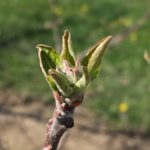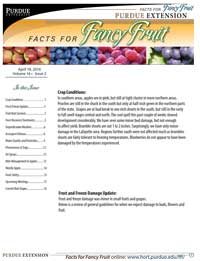Frost and freeze damage was minor in small fruits and grapes. Below is a review of general guidelines for when we expect damage to buds, flowers and fruit. Developmental stage 10% kill (°F) 90% kill (°F) Apples Silver tip 15 2 Green tip 18 10 Half-inch green 23 15 Tight cluster 27 21 Pink 28[Read More…]
What is the best way to assess bud damage from cold temperatures? Drs. Tara Baugher and Jim Schupp at Penn. State University have put together a nice page with some excellent photos explaining how to assess fruit bud survival: http://extension.psu.edu/plants/tree-fruit/news/2016/assessing-fruit-bud-survival-and-crop-potential I would add that unless you find that more than 90% of your buds have[Read More…]
There are some potential pest and disease problems that require early season sprays. Phomopsis is a major problem on many grape varieties in the Midwest. Mancozeb should be applied starting at 1-3 inch shoots and repeated each 7-10 days, especially prior to a predicted rain event. Colleagues in Michigan and Ohio have been conducting evaluations[Read More…]
As the spray season approaches, it is good to remember the profound impact water quality has on the performance of pesticides used by fruit growers. Purdue Pesticides Program recently published a guide, The Impact of Water Quality on Pesticide Performance PPP-86, available at the Education Store, 1-888-EXT-INFO or www.extension.purdue.edu/store/. I highly recommend this guide to[Read More…]
There has been some talk about the use of promalin to help overcome the damaging effects of freezing temperatures. Only a small amount of research has been conducted on this. Dr Steve McArtney showed that promalin applied after damaging freeze events could increase parthenocarpic (seedless) fruit development. Keep in mind this was only shown to[Read More…]
Weather for 2016 continues to be unpredictable. And although bad weather can damage crops, it does little to stop the pathogens that plague pome fruit. The past few weeks of cool weather has slowed things down, but not scab—at least, not completely. All plants, insects, and pathogens develop in response to temperature–The warmer the weather,[Read More…]
Ascospore release is timed to optimize infection, which happens around tight cluster through petal fall. This is when all the fun really begins: Ascospores are at their peak and ejecting, and apple tissue is expanding, providing a larger, susceptible canopy that spores can hit. That excellent timing is the poetry of evolution in motion. Other[Read More…]
One way insects communicate with individuals of the same species is with pheromones. Pheromones are volatile chemicals released by an insect that usually can be detected only by individuals of the same species. There are a number of different types of pheromones, but the most common type is the sex pheromone. Usually the females will[Read More…]
Purdue University prohibits discrimination against any member of the University community on the basis of race, religion, color, sex, age, national origin or ancestry, genetic information, marital status, parental status, sexual orientation, gender identity and expression, disability, or status as a veteran. This material may be available in alternative formats. 1-888-EXT-INFO Disclaimer: Reference to products in this publication is not intended to be an endorsement to the exclusion of others which may have similar uses. Any person using products listed in this publication assumes full responsibility for their use in accordance with current directions of the manufacturer.






